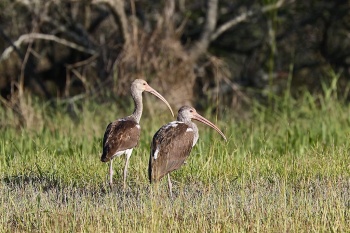(Attempt to disguise copied text. Links. Video link) |
(Imp sizes. Pictures of non-breeding adult, juveniles and flight. References updated.) |
||
| Line 1: | Line 1: | ||
'''Alternative name: American White Ibis to distinguish it from the [[Australian White Ibis]].''' | '''Alternative name: American White Ibis to distinguish it from the [[Australian White Ibis]].''' | ||
| − | [[Image:White_Ibis.jpg|thumb|550px|right|Photo by {{user|Steve+G|Steve G}}<br />Southern Dunes, Polk County, [[Florida]], [[USA]]]] | + | [[Image:White_Ibis.jpg|thumb|550px|right|Breeding Adult<br />Photo by {{user|Steve+G|Steve G}}<br />Southern Dunes, Polk County, [[Florida]], [[USA]], July 2005]] |
;[[:Category:Eudocimus|Eudocimus]] albus | ;[[:Category:Eudocimus|Eudocimus]] albus | ||
==Identification== | ==Identification== | ||
| − | + | [[Image:White Ibis 72 4213.jpg|thumb|350px|right|Non-breeding Adult<br />Photo by {{user|STEFFRO1|STEFFRO1}}<br />[[Huntington Beach State Park]], [[South Carolina]], October 2015]] | |
| + | 56–71 cm (22-27¾) long; 95 cm wingspan | ||
*All-white plumage | *All-white plumage | ||
*Black wingtips (visible in flight) | *Black wingtips (visible in flight) | ||
| Line 21: | Line 22: | ||
This is a [[Dictionary_M-S#M|monotypic]] species<sup>[[#References|[1]]]</sup>. | This is a [[Dictionary_M-S#M|monotypic]] species<sup>[[#References|[1]]]</sup>. | ||
==Habitat== | ==Habitat== | ||
| + | [[Image:White Ibis juveniles.jpg|thumb|350px|right|Juveniles<br />Photo by {{user|Stanley Jones|Stanley Jones}}<br />Laguna Vista, Cameron County, [[Texas]], [[USA]], October 2016]] | ||
Their favoured habitat is marshy wetlands and coastal pools. They also occur on mowed grass and have become common in some city parks. | Their favoured habitat is marshy wetlands and coastal pools. They also occur on mowed grass and have become common in some city parks. | ||
==Behaviour== | ==Behaviour== | ||
| Line 29: | Line 31: | ||
They builds a stick nest in trees, bushes, or over water. The clutch consists of 2 to 5 eggs. | They builds a stick nest in trees, bushes, or over water. The clutch consists of 2 to 5 eggs. | ||
====Diet==== | ====Diet==== | ||
| + | [[Image:615 10993fg2 White Ibis in Flight.jpg|thumb|350px|right|Breeding Adult<br />Photo by {{user|bobsofpa|bobsofpa}}<br />Venice Rookery, [[Florida]], [[USA]], May 2015]] | ||
They use the long, curved bill to probe in mud for a variety of fish, frogs and insects. | They use the long, curved bill to probe in mud for a variety of fish, frogs and insects. | ||
====Vocalisation==== | ====Vocalisation==== | ||
| Line 34: | Line 37: | ||
The birds often give a soft, grunting ''croo, croo, croo'' when foraging. | The birds often give a soft, grunting ''croo, croo, croo'' when foraging. | ||
==References== | ==References== | ||
| − | #{{Ref- | + | #{{Ref-Clements6thAug16}}#Keith Bildstein, ''White Ibis: Wetland Wanderer'' (Smithsonian: 1993), ISBN 1560982233 |
| + | #Handbook of the Birds of the World Alive (retrieved November 2016) | ||
#Wikipedia | #Wikipedia | ||
{{ref}} | {{ref}} | ||
Revision as of 21:41, 22 November 2016
Alternative name: American White Ibis to distinguish it from the Australian White Ibis.
- Eudocimus albus
Identification
56–71 cm (22-27¾) long; 95 cm wingspan
- All-white plumage
- Black wingtips (visible in flight)
- Reddish bills (extending into the face on breeding birds)
- Reddish legs
- Non-breeding birds show a pink to red face
Juveniles are largely brown with duller bare parts
Similar Species
Juveniles differ from the Glossy and White-faced Ibises by white underparts and rumps.
Distribution
Occurs from the mid-Atlantic coast of the United States south through most of the New World tropics.
Taxonomy
This bird hybridizes with the Scarlet Ibis, and they are sometimes considered conspecific.
This is a monotypic species[1].
Habitat
Their favoured habitat is marshy wetlands and coastal pools. They also occur on mowed grass and have become common in some city parks.
Behaviour
Action
In flight the neck and legs are outstretched and are often seen in long, loose lines.
Breeding
Monogomous and colonial, usually nesting in mixed colonies with other wading species.
They builds a stick nest in trees, bushes, or over water. The clutch consists of 2 to 5 eggs.
Diet
They use the long, curved bill to probe in mud for a variety of fish, frogs and insects.
Vocalisation
Call: the male advertises his presence with a hunk-hunk-hunk-hunk. The female squeals.
The birds often give a soft, grunting croo, croo, croo when foraging.
References
- Clements, J. F., T. S. Schulenberg, M. J. Iliff, D. Roberson, T. A. Fredericks, B. L. Sullivan, and C. L. Wood. 2016. The eBird/Clements checklist of birds of the world: v2016, with updates to August 2016. Downloaded from http://www.birds.cornell.edu/clementschecklist/download/
- Keith Bildstein, White Ibis: Wetland Wanderer (Smithsonian: 1993), ISBN 1560982233
- Handbook of the Birds of the World Alive (retrieved November 2016)
- Wikipedia
Recommended Citation
- BirdForum Opus contributors. (2024) White Ibis. In: BirdForum, the forum for wild birds and birding. Retrieved 10 May 2024 from https://www.birdforum.net/opus/White_Ibis
External Links







